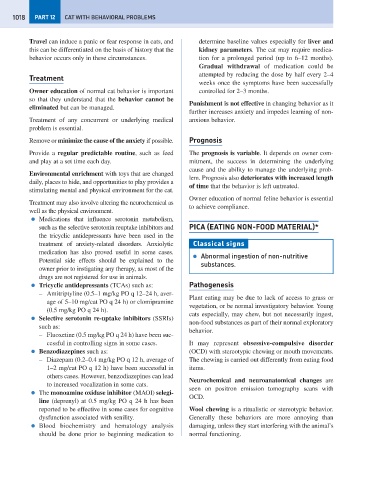Page 1026 - Problem-Based Feline Medicine
P. 1026
1018 PART 12 CAT WITH BEHAVIORAL PROBLEMS
Travel can induce a panic or fear response in cats, and determine baseline values especially for liver and
this can be differentiated on the basis of history that the kidney parameters. The cat may require medica-
behavior occurs only in these circumstances. tion for a prolonged period (up to 6–12 months).
Gradual withdrawal of medication could be
attempted by reducing the dose by half every 2–4
Treatment
weeks once the symptoms have been successfully
Owner education of normal cat behavior is important controlled for 2–3 months.
so that they understand that the behavior cannot be
Punishment is not effective in changing behavior as it
eliminated but can be managed.
further increases anxiety and impedes learning of non-
Treatment of any concurrent or underlying medical anxious behavior.
problem is essential.
Remove or minimize the cause of the anxiety if possible. Prognosis
Provide a regular predictable routine, such as feed The prognosis is variable. It depends on owner com-
and play at a set time each day. mitment, the success in determining the underlying
cause and the ability to manage the underlying prob-
Environmental enrichment with toys that are changed
lem. Prognosis also deteriorates with increased length
daily, places to hide, and opportunities to play provides a
of time that the behavior is left untreated.
stimulating mental and physical environment for the cat.
Owner education of normal feline behavior is essential
Treatment may also involve altering the neurochemical as
to achieve compliance.
well as the physical environment.
● Medications that influence serotonin metabolism,
such as the selective serotonin reuptake inhibitors and PICA (EATING NON-FOOD MATERIAL)*
the tricyclic antidepressants have been used in the
treatment of anxiety-related disorders. Anxiolytic Classical signs
medication has also proved useful in some cases.
● Abnormal ingestion of non-nutritive
Potential side effects should be explained to the
substances.
owner prior to instigating any therapy, as most of the
drugs are not registered for use in animals.
● Tricyclic antidepressants (TCAs) such as: Pathogenesis
– Amitriptyline (0.5–1 mg/kg PO q 12–24 h, aver-
Plant eating may be due to lack of access to grass or
age of 5–10 mg/cat PO q 24 h) or clomipramine
vegetation, or be normal investigatory behavior. Young
(0.5 mg/kg PO q 24 h).
cats especially, may chew, but not necessarily ingest,
● Selective serotonin re-uptake inhibitors (SSRIs)
non-food substances as part of their normal exploratory
such as:
behavior.
– Fluoxetine (0.5 mg/kg PO q 24 h) have been suc-
cessful in controlling signs in some cases. It may represent obsessive-compulsive disorder
● Benzodiazepines such as: (OCD) with stereotypic chewing or mouth movements.
– Diazepam (0.2–0.4 mg/kg PO q 12 h, average of The chewing is carried out differently from eating food
1–2 mg/cat PO q 12 h) have been successful in items.
others cases. However, benzodiazepines can lead
Neurochemical and neuroanatomical changes are
to increased vocalization in some cats.
seen on positron emission tomography scans with
● The monoamine oxidase inhibitor (MAOI) selegi-
OCD.
line (deprenyl) at 0.5 mg/kg PO q 24 h has been
reported to be effective in some cases for cognitive Wool chewing is a ritualistic or stereotypic behavior.
dysfunction associated with senility. Generally these behaviors are more annoying than
● Blood biochemistry and hematology analysis damaging, unless they start interfering with the animal’s
should be done prior to beginning medication to normal functioning.

